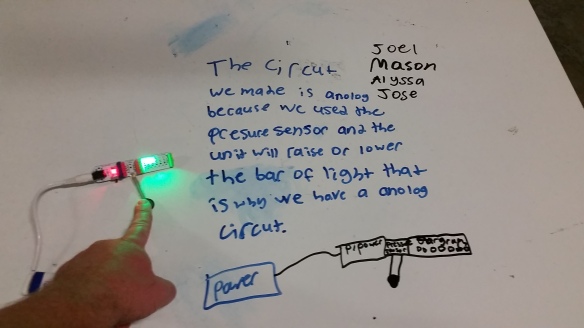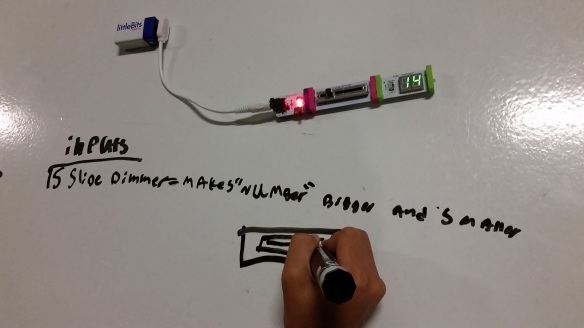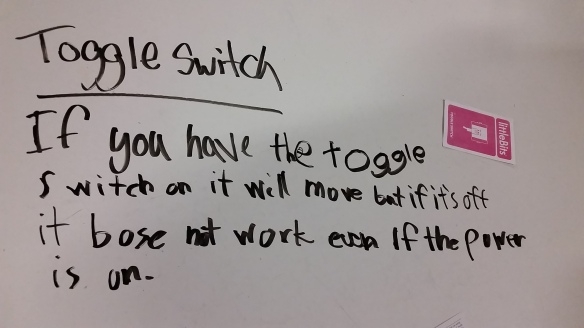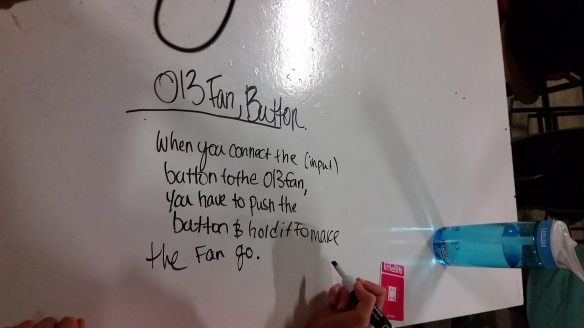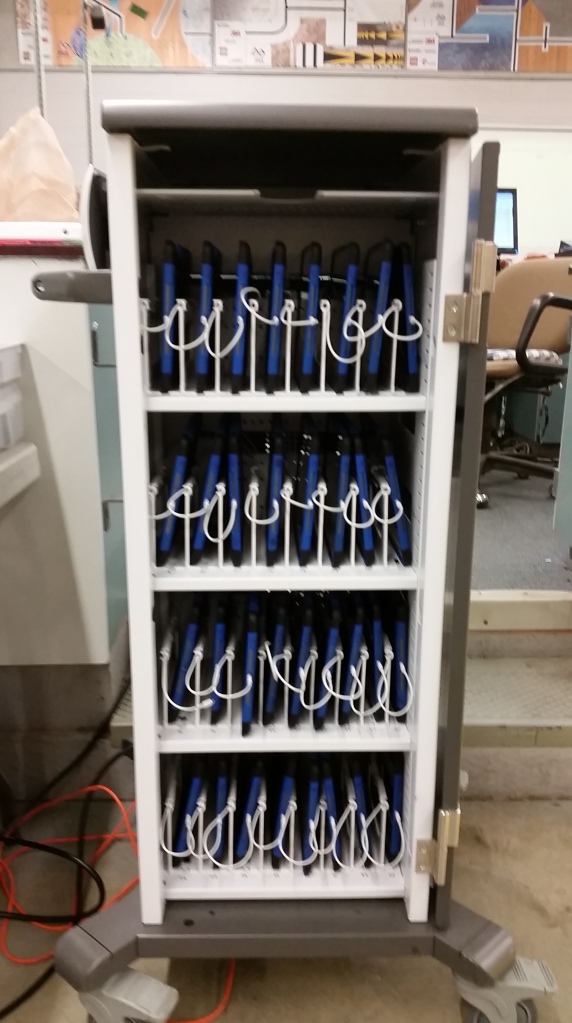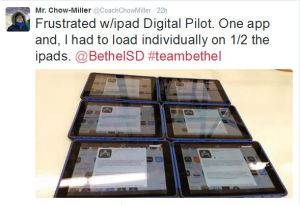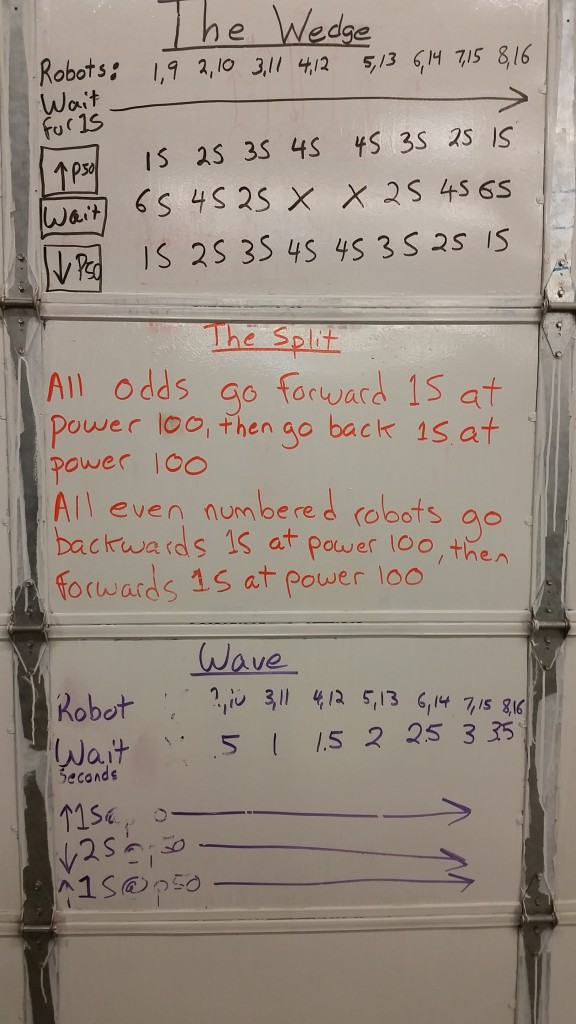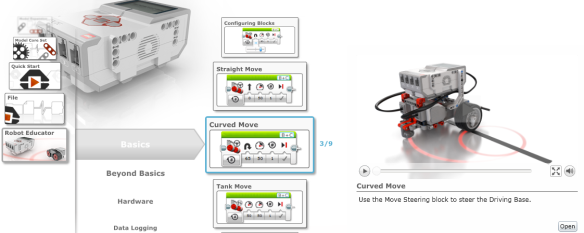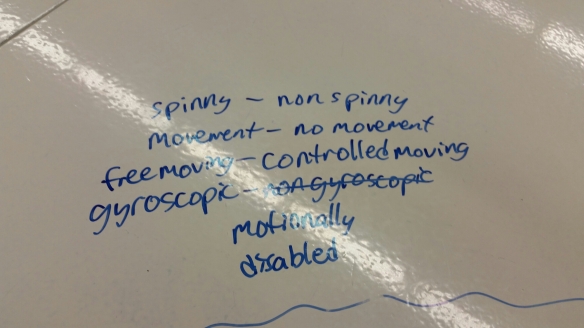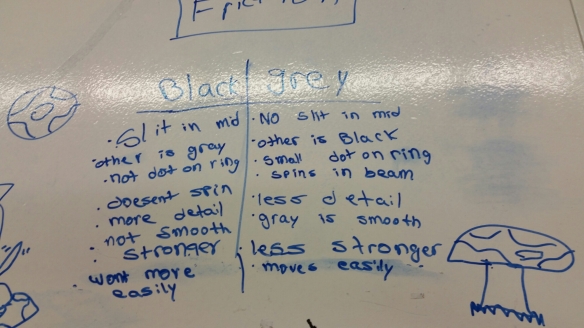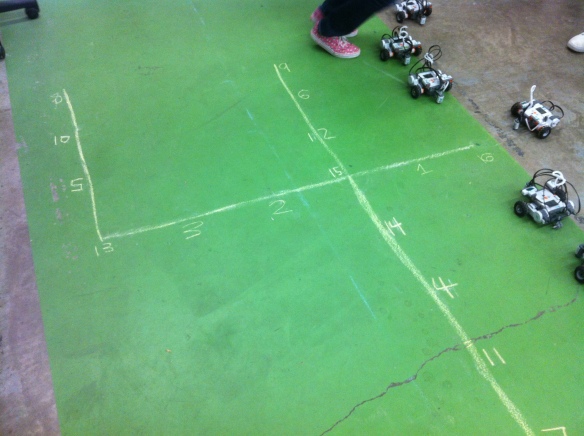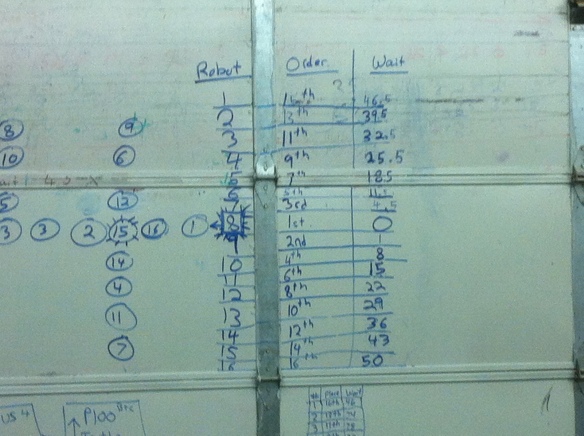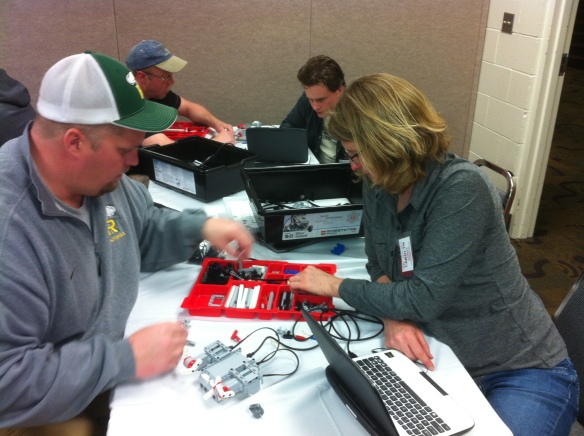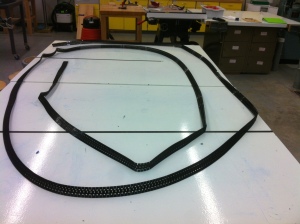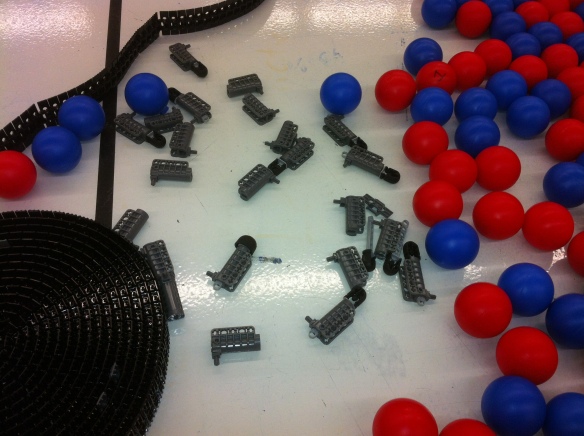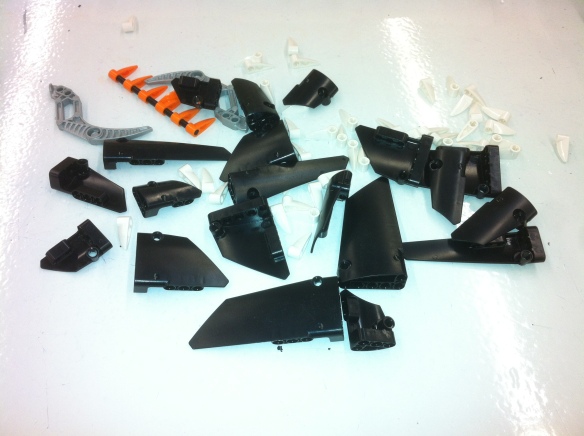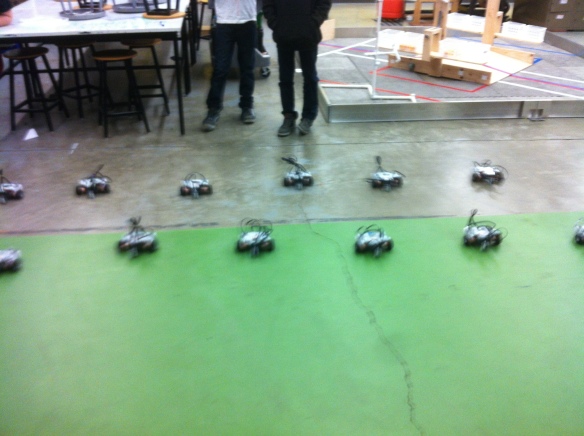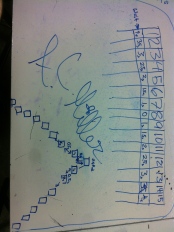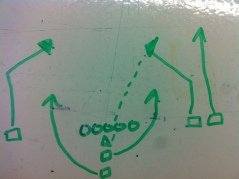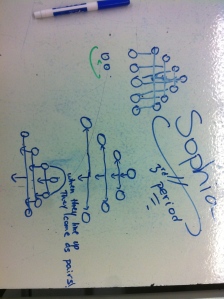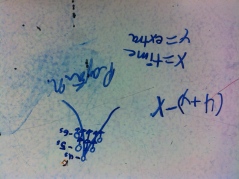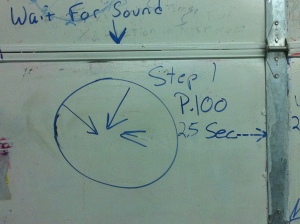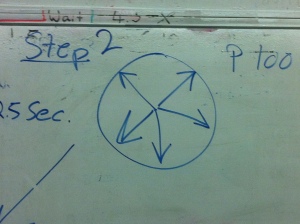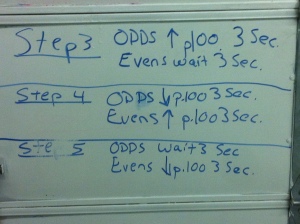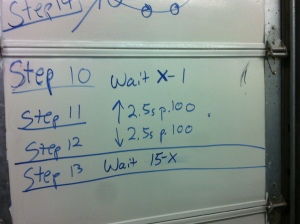I was honored recently when my school nominated me for Teacher of the Year. I was dumbfounded when I found out just what is involved in the process. I understand that it is a big honor and they really want to vet nominees so each district, region, and state chooses the best. But this was a lot of work to do in less than a month’s time. Especially if you have other personal and professional responsibilities as I imagine most nominees do. I think perhaps teachers would be better served if they had to do a couple of the writing pieces at the school level. This would let them know what was involved, and give the school’s nominee a head start on the process. Each piece they asked you to write was a worthy reflection on our profession, but very time consuming.
It came down to the wire but I did manage to finish everything and hand it in on time. Below are all the writing components I had to do. Please use them for inspiration or ask questions or make comments. I’d love to hear what people think.
I’ve attached it as a .pdf file if that’s easier for you to read, or you can just scroll down and begin.
Teacher of The Year – All My Documents
Teacher of the Year Nomination Packet
Ian Chow-Miller – 2014
Frontier Middle School, Bethel School District
Professional Biography (1,000 words max)
- What were the factors that influenced you to become a teacher?
- Describe what you consider to be your greatest contributions and accomplishments in education.
There must be a similar moment in most teachers’ lives, the one where they think, “I can teach better than I was taught. I can connect with kids, I can make a difference.” And so it began for me in the University at Buffalo as I began a teaching program. I enjoyed my study as I took regular teaching classes, did regular student teaching in a suburban High School similar to the one I went to and earned my first job teaching at a distinguished school on Long Island just one town over from my hometown and I was phenomenally … mediocre.
I fell into old rhythms, teaching Social Studies very similarly to how I was taught: chalk and talk, copy these notes, read this chapter, study this handout, answer these questions, essay due Friday, and test on Thursday. And because I was in a wealthy district at a distinguished school with 94% of the students going on to college, I thought I was doing well. My students seemed to like me; I had made it. Or so I thought.
As a leave replacement teacher, I found myself out of a job at the end of June but I was young, eager and motivated so I wound up at a similar school in a similar district. And of course I fell into familiar habits. Transparencies and overhead projectors replaced chalk and erasers and made me think I was being truly innovative. These students if anything were more motivated than my last group: they showed up to class early, wrote down every note I put on the board, came to extra study sessions, and argued every point. Kids liked me, I was funny, I worked well with other colleagues designing interdisciplinary units and again I thought I had made it.
After two years that position ended and I did not find employment in any of the good schools in which I thought I belonged. So after a miserable year pretending to belong in corporate America, I found myself teaching in the South Bronx and my education as a teacher really began.
Chaos. Violence. Neglect. Disrespect. I was in another world. These kids did not want to learn, there was no grade grubbing, and forget showing up early and taking notes, it was a struggle to get a lot of them to show up at all. I quickly learned that yelling did not yield results; you could not make these kids do anything. Their daily lives were tougher than anything I could throw at them. So now I had to teach. Really teach.
I began by developing what was beautifully referred to in an episode of HBO’s The Wire as “soft eyes.” These kids needed compassion and understanding coupled with consistency and high expectations. You weren’t going to receive respect because you thought it was owed you, you were going to work hard to earn it and harder to keep it. Teachers had to be there for students, willing to support them in all things and in all ways; a student who had a knock-out, drag-down fight one day, might need help with her essay the next – to judge or refuse to work with the tough ones was the easy way out, one I refused to take.
It was not easy, it was not pretty, and it definitely was not the wealthy suburbs. But I reveled in the work and felt like I was actually making a difference as a teacher. I put in the effort and time to work with my students, to show them that I cared, to stay after and arrive early, to create meaningful work that related to their lives. And I slowly started to see results, but I needed more.
During my third year in the South Bronx two important events occurred: I was asked by my Principal to attend a Robotics’ training and in my graduate course work I was introduced to constructivism – the idea that people construct their own meaning and learning by mixing new knowledge with prior knowledge. Constructivism placed learning as integral to who each person was, not as the process of copying notes, memorizing information and regurgitating it back. That is how I was taught and how I had started teaching. Now I had a better philosophy to guide me and it fit perfectly with Robotics.
Robotics allowed me to soar as a teacher. I could pose to students real world problems with multiple solutions, provide them the tools to create their answers and demonstrate their understanding, and authentically assess them. Students were constructing their own learning and loving it. One of the best early units I did with Robotics was the “assistive devices” unit where students created robotic devices to help people with physical disabilities. Students who were not passing any classes were creating robotic arms and “ultrasonic” eyeglasses, out of LEGOS!
People are shocked to hear that I moved across the country based on a family decision, not to escape my job. I arrived in Bethel School District expecting to teach Social Studies. Within the first two months I was piloting a Robotics’ class, which became mandatory for every 7th grader, and has now spread to every middle school in our district. This is what I am most proud of, taking something in education I love and believe in and spreading it to the educational community. The validation you receive when your course and your ideas are picked up and replicated by others is extremely rewarding.
I haven’t forgotten what I learned about compassion and understanding, consistency and high expectations, hard work or my adherence to a constructivist philosophy. These are universal values which apply in education everywhere. And I’m still learning and sharing ideas every chance I get. But I can now say that I teach differently than I was taught, I make real connections with kids, and I definitely make a difference.
Community Involvement: (500 words max)
- Describe your commitment to your community through service oriented activities such as volunteer work, civic responsibilities and other group activities.
Community involvement should emanate from what you’re passionate about and skillful at. Robotics and STEM is where I stake my claim, so around these subjects I have centered my community activities.
When CTE began to form FIRST LEGO League (FLL) teams at middle and elementary schools in 2010 I realized that almost all of the coaches were new and very inexperienced. CTE had a big stake in the success of Robotics and having coached FLL since 2004 I knew it was a great program for kids. I decided to open my shop up for a robotics’ workshop one Saturday each month in the fall.
My team and I would host these workshops, which were often attended by over 100 people on as many as ten different teams. I had the building space, materials, robotics’ knowledge, familiarity with FLL, and a full computer lab. All teams had to do was show up. The controlled chaos that ensued was beautiful. Kids would lie on the floor or gather at tables – anywhere they could to build robots. Others sat at computers trying out their programs. Coaches sought advice on the research project or how to install programs on their laptops and I tried to instill some sort of order. Best of all was the sharing.
The only rule at the workshops was you must share. Share your ideas, your builds, and your programs – anything you come up with. My team learned as much from other teams as their coaches learned from us. The culminating event of each workshop was a big “show and tell” where every team would gather around the competition field and each team would get a chance to demonstrate what they had done. Some shared a complete program, others just the skeleton of a build. Whatever you had done, you were cheered and left feeling good about yourself and your accomplishments. I have been running these workshops for four years and do not intend to stop any time soon.
There was an even gender split among these teams at the elementary level but as the teams got older, the population definitely skewed male. We had an answer for this. John Davis (from Liberty MS) and I attended training on how to host an event with the tongue in cheek name Mother Daughter TEA. The TEA stood for Technology Engineering Aptitude event. The goal of these events was to get more middle school girls interested in engineering careers.
At our first TEA we had challenges for the students and their mothers, gave information out about engineering careers, explored opportunities in Bethel School District, but the highlight was the guest speakers. We had female scientists and engineers from Boeing speak to the girls about their experiences of being a minority in their engineering programs and in their jobs. They captivated the audiences’ attention, and you could see that little light bulb go off in a few faces, “If they can do it, so can I.”
Philosophy of Teaching: (1,000 words max)
- Describe your personal feelings and beliefs about teaching, including your own ideas of what makes you an outstanding teacher.
- Describe the rewards you find in teaching.
- How are your beliefs about teaching demonstrated in your personal teaching style?
“Choose to make mistakes, do it often, dive in, don’t raise your hand and ask someone else.” This tongue in cheek phrase sums up my teaching philosophy quite succinctly as I want students to have choice in how they approach their assignments, learn from making mistakes, dive into projects head first, understand that I’m calling on anybody not just the raised hands and to seek answers, ideas and help from each other before they ask me.
It is vital to let students make mistakes when they are trying something for the first time. In my class we celebrate those mistakes because we learn from them. When the playground a group makes in Autodesk Inventor doesn’t fit together because the platform is twice as high as the slide, they have now learned why it is important to make sure the measurements of each designer’s part matches all the others. I can tell them this at the beginning, but they do not really learn it until they make a mistake and have to redo their work.
Mistakes are learning opportunities. In Robotics one of our initial units is a synchronized robot dance. Each time we test part of the dance and a students’ robot makes a mistake, they are tempted to quickly pick it up. By teaching them not to touch their robots, we can begin to explore what their robot might have done to end up where it did. This process is slow to take hold at first, but once students are comfortable making mistakes, they take more chances and are able to learn more from their experiences.
Having students dive in to difficult concepts before I have fully explained them yields better results than prefacing them with too much information. For example in my drag racer unit there are many factors that will affect your robot’s speed: proper gear ratio, weight, balance, structural integrity, inertia, etc. I used to teach all of these at the unit’s beginning. Students would quickly become bored and I would get frustrated. Now I have them dive in and build with very little introduction from me. Inevitably problems will arise and the students become frustrated. At this point they are ready and eager to learn the factors that might affect their robot’s speed.
When working on a project I like to give students choice. When students get to choose they become invested in their learning, are more likely to learn the skills, and produce amazing results. In Robotics our first project is a dance called “The Wave” which teaches students basic robot movement. After replicating “The Wave”, each class gets to design their own robot dance. The coolest projects I have ever seen have arisen from this choice. No words of mine could do justice to the sight of a group of robots decorated with colored feathers and pipe cleaners, holding smart phones with the strobe light app turned on, dancing to the Harlem Shake.
Last year I attended a professional development based on the Danielson Framework. I had such an “aha” moment during one video that I’ve changed a major facet of my teaching because of it. A narrator insisted that asking students to raise their hands to answer questions was one of the worst ways to teach. It made the smart kids smarter and allowed everyone else who might not know the answer to hide. It seems so simple when stated like that, but it’s not what I was taught to do as a teacher. But once I saw that video I switched. Before asking any question, I direct students to turn towards each other to discuss their answers with a partner, neighbor, or group. After that, anybody is game for being called upon. “I don’t know” is not acceptable anymore in my class.
The teacher as facilitator is the final component of my teaching philosophy. Engineering design and robotics’ programming is too complex for me to ever master them fully. I have students who know how to do things I am not familiar with in these areas. We know that students learn better from peers than from adults, so I take advantage of this and allow students to teach each other or learn how search for their own answers. I can guide them, help them with search terms, teach them how to use Help Menus, provide context for their queries, and put them together with other students; anything but come directly to me every time they have a question. Some teachers sum this up simply as, “Ask three before me.”
The rewards of teaching are a cliché that are true most teachers. When your students “get it,” when their faces smile because they achieved something great, when they write you an e-mail telling you how much they love your class – these are the rewards that every teacher gets. A few days ago, I received a bonus reward.
I struggled with writing this piece more than any other. To put into words what I believe about teaching and what I do in the classroom is exceedingly difficult. Am I as good as I think? Do I really teach in a way that is consistent with my beliefs? These things are hard to judge and left me with some lingering self-doubt. Then I received one a letter of recommendation from a former student and was astounded. Amongst his words of praise were specific references to the teacher not giving straightforward answers, but instead providing students with “the tools to communicate and work together.” Further he wrote, “It provided a better working experience … because mistakes were not punished, they were celebrated as a chance to learn.” He ended with reference to my allowing students to “build in the way they felt best suited the task at hand.” No reward could be greater than having a favorite student validate my own methods and philosophies in such a glowing fashion.
Responsiveness to Education Issues and Trends: (1,000 words max)
- What do you consider to be the major public education issues today?
- Address one in depth, outlining possible causes, effects and resolutions.
I have taught in what are considered the very best and the very worst schools in America. To compare the disparities in education between the north shore of Long Island and the South Bronx could fill a novel. One my mother says I should write some day. To boil it down to a few issues and to focus on one in particular requires shedding emotional connections and taking a hard look at American values. It doesn’t take a genius to see money as the major disparity and the root of some of the biggest problems in American education: class size, the use of local tax dollars to fund public education and the status of teachers in our society.
I teach classes which range in size from thirty to thirty four students. From where this became an allowable or acceptable number I have no idea. In a fifty-minute period I can give one and a half minutes of dedicated time to each individual student. Not a lot of time left over for instruction or more deep discussion. I have heard many ways around this: have the student talk to each other, peer grading and evaluation, focus on a few students each week, etc. All of these are a cover up for the main problem. Nothing is more important than the one on one feedback that exists between a teacher and a student. Telling a student that they did well on something and the next part is really hard but you know they can do it if they really try is a powerful message coming from a teacher, one that I cannot communicate if I do not have the time to meet with students. But smaller class sizes costs money!
Yes they do and the state courts have ruled that Washington schools are short changed by a large margin (McCleary v. State). In this landmark case, Justice Debra Stephens, declared that the state legislature has failed to fulfill its paramount duty under the constitution to “make ample provision for the education of all children residing within its borders…” And the legislature is working on ways to address this massive funding gap by which less money is spent per pupil on Washington than twenty two other states (2010 statistics pulled from http://www.census.gov/govs/school/). Indeed the courts have given them until 2018 to fix the funding. Every student I teach will be close to graduation by then; but there are things we can do right now.
Bethel spent countless thousands of dollars on the Making Middle Grades Work and High Schools that Work programs. When I joined Bethel in 2008, this was our focus. All our efforts were trained on stuff in our TAV (Technical Assistance Visit report) provided by the MMGW/HSTW parent organization. In 2014 I doubt anyone in my school could locate our last TAV report. I wonder how much money has been spent on training and preparation for the WASL, I mean the MSP, I mean, Common Core. I don’t mean to be flippant; I’m sure there are educationally sound reasons for using three different testing regiments in less than a decade. I’m equally sure that without any of these test my students would have been better educated if the funding to choose, evaluate, administer, and grade them had been used to reduce class size and of course pay teachers more.
Teacher pay in Washington State has declined from 5th in the nation in 1981 to 23rd in the nation in 2011 (www.washingtonea.org). That sends a horrible message to teachers and school and the general public. Lip service is often given to the importance of teachers, but we live in a capitalist society and the way we show value is by placing a dollar amount on things. Clearly teachers have lost value in the eyes of Washingtonians as our salaries have declined, our COLA has been cut, and our buying power has not even kept up with inflation. If you want good teachers, you must pay them well. We all do this job for the intrinsic rewards, none of us expect to get rich teaching, but we would like to be fairly compensated. If you want a pool of great teachers to choose from you need to attract them. And you don’t do that by advertising a thirty-year trend of declining salaries.
The solutions to this underfunding of schools are not easy. Nobody wants to pay more in taxes and nobody wants to cut other vital services. I do have two ideas that are closely tied together and supported by the findings in McCleary. In my ideal world local tax dollars would not fund education at all. Money would be distributed equally on a per-pupil basis throughout the state. This is not a widely popular position; it means if you live in a high-income bracket you don’t get more money for your schools. While people cry foul on this, the alternative is admitting we don’t have an equal education system and that poor people don’t deserve the same education as others. It creates an ever-permanent underclass, like the one I taught in for eight years in the South Bronx. This sounds un-American and not what our country is about, yet it is the funding method we stick to. There is however a compromise to be had with my second idea.
In the McLceary decision it was pointed out that WA receives 66% of its school funding from state taxes and 19% from local taxes. The courts stated unequivocally that 19% was too high. Even if you don’t go to a total equal distribution like I advocate, cutting down that 19% would be a good start to properly controlling and distributing funds across WA.
Even with a better distribution, the problems of class size and teacher pay (recruitment and retention as well) are directly tied to the funding of WA schools. These will not improve until the state legislature meets its basic obligation.
Commitment to Strengthening the Teaching Profession:
- What do you do to strengthen and improve the teaching profession?
- What is and/or what should be the basis for accountability in the teaching profession?
To strengthen the teaching profession a teacher must share. You have to confidently share what you are good at and you must bravely be willing to share those areas of your class and teaching where you feel you need help. You must also seek out professional development and training wherever you can find it; each teacher needs to be responsible for finding the help that will be most beneficial to them, you cannot rely only on your district provided professional development.
I am very good at teaching Robotics and this is what I have chosen to share with other educators. I wrote the Robotics’ curriculum for Bethel’s middle schools. At Summer Institute I have conducted robotics’ training for teachers in and out of our school district. I also have delivered presentations on Robotics at the conferences of the two professional organizations I belong to: WITEA (Washington Industrial Technology Education Association) and WA-ACTE (Washington Association of Career and Technical Education).
For the past three years I have been a member of LEAP (LEGO Education Advisory Panel). This distinguished honor has allowed me opportunities to reach teachers beyond my school district. I have conducted training on their new robotics’ platform, EV3, in Yakima, Oregon, and even California.
Through my membership in LEAP I have met many people who work closely with LEGO Education. I was honored to host one of their curriculum developers, Robert Widger from the UK, at my home last September. He came to my class to observe my teaching and he presented some of the new curricula modules LEGO Education was working on for the EV3 and asked me for input in shaping these modules.
Mark Gura, the former Director of the Office of Instructional Technology for New York City’s Department of Education, has interviewed me at length. He has included information from these interviews in his book, Getting Started With LEGO Robotics: An A to Z Guide for Educators, as well as in articles he has penned for several education and technology journals, such as George Lucas’ Edutopia.
I participate in less formal – yet still highly informative discussions on education via the Internet. I am participating in MIT’s (Massachusetts Institute of Technology) MOOC (Massive Online Open Course) Creative Learning. Literally thousands of teachers and students from around the world took this course last fall. On Twitter I chat with other educators from around the world and join a weekly discussion under the hashtag #roboedu. For years I have contributed to the LEGO Engineering Google Group, which is probably one of the longest running conversations about LEGO Robotics. These ground-up efforts help me engage in substantive discussions about the issues that directly affect me and other educators.
There are no sign-in sheets with these courses, no clock hours and no district official told me I had to take them or which ones to take. The motivation for participating in them is intrinsic and the accountability is internal. That is how I believe education should work in an ideal world, everybody works to improve him or herself and make their teaching stronger in whatever way they feel is needed.
One of the strongest methods of improvement I have ever come across was early on in my career when I participated in an experimental methodology with a cohort of teachers. We met together and discussed things we felt needed improvement in our own classes. Then one teacher would volunteer to have his or her class observed by the cohort. The rule was the teacher would tell the rest of the cohort what they should look for. And that was the only thing you were allowed to take notes on or comment on in the debriefing sessions afterwards. This was powerful and extremely helpful, but took a lot of courage to open your classroom your teaching up to scrutiny – even with the given guidelines.
I am not so naïve as to believe that all teachers seek self-improvement or are comfortable enough to lead trainings or motivated enough to create and participate in their own pedagogical discussions on-line or elsewhere. So there has to be some accountability other than to yourself.
I appreciate the domains and criteria set forth for teachers in the Danielson Framework. Accountability based on this system can be quite good. Most of it speaks directly to what I consider important teaching practices: planning, instruction, professional responsibilities, and classroom environment. However there are two areas where I think WA State and Bethel need to pay closer attention to how they implement the evaluative portion of framework: domains 4d and 4e (participating in a professional community and growing professionally) and the use of standardized test scores as part of a teachers’ rating
I am the only teacher of my three subjects in the building. I grow professionally and participate in learning communities by reaching out beyond my class and building and even my PLC of like teachers in the other middle schools. Technology has allowed me to do that and given me the flexibility to do it in a way that I choose and that fits my schedule. We need to recognize this, encourage this, and account for this in our evaluative process.
Danielson’s framework does not specifically state that standardized test scores need to be used in teacher evaluation, but WA State seems to be leaning that way. My reasons against this are another essay altogether, but my simple and constant argument is this: I am a much better teacher now then I was in the South Bronx six years ago, and was much better six years ago than I was ten years prior to that when I began. However if you tie my evaluations to my students’ test scores I would have been a phenomenal teacher my first year, horrible in my middle years in the South Bronx, and middle of the pack now that I’ve been nominated for Teacher of the Year by my school.
Teacher of the Year Platform: (500 words max)
- If you were selected the Washington State Teacher of the Year, you would serve as a spokesperson and representative for the entire teaching profession.
- What would be your message?
- What would you communicate to your profession and to the general public?
If chosen to represent Bethel School District and WA State as Teacher of the Year, my message would be simple: students are more than test scores. We must break down the notion that they are the sum of the scores they receive on standardized tests and we need to stop concentrating a large portion of our resources on these exams. I need to look no further than the “Star Wars Dictionary” my six-year-old son is writing to understand this concept. He created this wholly on his own based on his love and passion for the Star Wars© movies, Angry Birds Star Wars© and LEGO© Star Wars.
In this amazing document he has named all twenty franchise movies that he insists will be released, and designed movie posters for each one. He has written and drawn page after page of Star Wars related stuff all from his imagination. None of this amazing work would show up on a standardized test. Common Core or MSP or WASL or SATs would recognize none of it. Yet to me it is the single most important and beautiful thing he has created in his short life.
This is why I teach Robotics. Students in my class get to explore and create with their hands. They program and design, build and collaborate and none of this would show up on a standardized test. It was not long ago that phrases like “educating the whole child” and references to Howard Gardiner’s multiple intelligences were on every educator’s lips. These fell by the wayside when No Child Left Behind was passed.
Diane Ravitch was Asst. Secretary of Education under both Clinton and Bush (the younger) and was a major proponent of standardized testing and No Child Left Behind. After the passage of NCLB she quickly became disillusioned with it and its most vocal critic. In her 2010 book, The Death and Life of the Great American School System: How Testing and Choice Undermine Education, she stated unequivocally “I no longer believe (standardized testing) will produce the quantum improvement in American education that we all hope for.” She went on to say, “High stakes testing, draconian penalties, school closings… don’t work.” I couldn’t agree more.
There is nothing wrong with standards or standardized testing. When these are used to help a teacher see where their students are on certain measures, they can be invaluable. When they are used as the sole determining factor in a student’s future and as a way to punish schools and teachers, then they have lost their purpose and are being misused.
Students are more than test scores. If you want them to write well, help them find their passion so they can write about that. Let them sing and dance and draw and build and blog and make movies about it too. Stop narrowing the focus of public education through the use of these tests. I want every child to produce their own “Star Wars Dictionary.”
Attach a brief resume.
- Include the following details: educational background, educational and professional experiences, leadership experience, professional organizations, and honors received.
- Please make sure your home and school phone numbers are included on your resume.
- (Use no more than two pages and begin each section with the most recent).
Ian Chow-Miller – Resume
1101 S. Tyler, Tacoma, WA 98405 – (347) 217-3503 (home) – (253) 683-8450 (school)
Certification
- WA State Social Studies and History 7-12 Permanent
- WA State CTE STEM/Robotics Renewable
- Project Lead The Way – Gateway to Technology and Introduction to Engineering Design
- NY State Social Studies 7-12 Permanent
Career Highlights
- Advise LEGO Education on the development of its products and curriculum. I am in my third year as a member of LEAP (LEGO Education Advisory Panel). I am proud of this honor (only thirty out of 3,000 applicants were chosen my first year) as LEAP brings together teachers from pre-K to University to help direct their product development. We are given “sneak peeks” and early access to products and curriculum and offer advice through all stages of development.
- I created and ran a workshop for LEGO Ed. at the National Science Teachers’ Association (NSTA) conference in Portland on making robots “Move Without Wheels.”
- Conduct training, run workshops, and present at conferences (WITEA, WA-ACTE) on teaching Robotics. In 2011 I won “Best Presentation” at the WITEA conference in Wenatchee. This past year I have free-lanced for LEGO Education, training teachers from Yakima to California.
- Developed and implemented my own Robotics’ curriculum while teaching in the South Bronx. While initially hired at Frontier to teach Social Studies, the Bethel CTE department asked me to pilot my Robotics’ curriculum there; after one year it was expanded into all six Bethel middle schools. I still oversee its development and the training of teachers. Nothing brightens my day more than helping students explore, create, and design solutions to problems using robots.
- Coached FIRST LEGO League (FLL) from 2004 and FIRST Tech Challenge (FTC) teams from 2010 to the present. While often winning (this year my FLL team made it to state semi-finals and in 2009 my FLL team made it to the state championship) I have always valued the challenge of helping to mold a disparate group of young teenagers into a cooperative and competitive team that builds and programs robots.
- Coached Girls’ JV Soccer 2010-present.
- Of the many roles I have fulfilled (AVID coordinator, School Leadership Team, grade leader, technology representative, and newsletter and website editor) a recent one I am very proud of is being a WEB (Where Everybody Belongs) Coordinator this year. After receiving our own training the WEB Coordinators turn-keyed it for a group of (soon to be) 8th graders. These 8th grade WEB Leaders independently ran the 6th grade orientation and it was a huge success. Watching students be successful on their own is a great satisfaction to me.
- Interviewed at length for Mark Gura’s book: Getting Started with LEGO Robotics: A K to 12 Guide for Educators. Mr. Gura, the former director of Technology for NYC Dept. of Ed., has also included interviews and information on my classes and curriculum in articles for ISTE’s Leading and Learning with Technology, Edutopia, and the Robotics for Teachers podcast.
- While teaching in the South Bronx, students in my Social Studies class produced a first place video in the Teaching Matters Digital Documentaries competition. Though this was ten years ago – before smartphones – the video, about Brown v. Board of Education, is still featured by Teaching Matters.
Work Experience:
Frontier Middle School (Graham, WA) 9/2008 – Present
- Taught, Robotics, Gateway to Technology, Introduction to Engineering Design, Social Studies.
- Coached FLL, FTC
- Coach Girls’ JV Soccer
- WEB Coordinator
- Newspaper and Website Editor
- School Leadership Team member
- ACT (Advisory Council on Technology) Representative
IS 318 (South Bronx, NY) 9/2002 – 6/2008
- Instructional Technology Coordinator (’07-’08)
- Developed and taught new Robotics and Technology classes to 6th and 7th grade, including bilingual classes.
- Taught 7th grade US History.
IS 139 (South Bronx, NY) 9/2000 – 6/2002
- Taught US History to five 7th grade classes.
Great Neck South Middle School (Great Neck, NY) 9/1997 – 6/1999
- Social Studies – taught four 7th grade classes of US History in a team environment.
- Met daily with team teachers to monitor progress of students and to design and implement enrichment, intervention or whatever other services students required.
Roslyn High School (Roslyn, NY) 9/1996 – 6/1997
- Social Studies teacher – taught two classes of Global Studies I Honors, one class of Global Studies I Regents, and two classes of Global Studies II Regents.
- Coached Lincoln Douglas Debate club; the team consistently won regional competitions and sent many finalists to NY State and National competitions.
Education
- New York Institute of Technology
Master of Science, Instructional Technology, August 2003
Graduated with Distinction, 3.8 GPA
- State University of New York at Buffalo
Bachelor of Arts, February 1994; Major: History, Minor: Education
Professional Organizations:
- Washington Industrial Technology Education Association (WITEA)
- Washington Association Career and Technical Education (WA-ACTE)
- LEGO Education Advisory Panel (LEAP)
Note – in my actual resume I include hyperlinks to many of the videos and websites I reference. However for Teacher of the Year, the packet had to be all paper, so I removed these as the bright blue underlined words look silly on paper. J
Four Letters of Recommendation.
- It is required that at least one letter be from your supervisor.
- For the others, you are strongly encouraged to include letters from parents, students, and colleagues.
- You may want to ask the person who nominated you to include a letter.
- (Letters – 1 page max; ONLY 4 letters are accepted; additional letters will be discarded)
February23, 2014
Dear Teacher of the Year Selection Committee,
I strongly support Mr. Ian Chow-Miller for this distinguished honor because Ian is a distinguished teacher. I cannot think of a more deserving teacher for this award. A hard working professional, Ian is an excellent classroom instructor, an expert in his field, an advocate for students, and a mentor for colleagues. He strikes the perfect balance between strong positive relationships with students, high expectations, fun activities and challenging work.
In addition to excellent classroom teaching what separates Ian from other great teachers is his involvement with students in a variety of ways and his leadership among his peers both at Frontier and throughout the district and beyond. Ian works with students outside of the normal school day as a Robotics Club Advisor, soccer coach, and coordinator for our Where Everybody Belongs student transition program. Most impressively Ian has opened his classroom the last several years on Saturday mornings to Robotic teams throughout the district for workshops. By mentoring and guiding new teams and coaches at these workshops, he has helped make true Bethel’s CTE slogan, “FIRST in Robotics.”
Ian also writes our school newsletter, updates our school website, and has served as department leader on our school Site Council. Outside of school Ian’s leadership amongst his peers is evident as he writes curriculum for the district, provides training for other teachers at Summer Institute and throughout the year and works as an advisor on the nationally recognized LEGO Education Advisory Panel.
I encourage you to select Ian Chow-Miller as Bethel School District’s 2013-2014 Teacher of the Year. I cannot imagine a more deserving candidate. If you have any questions, or if there is anything more I can do or say to convince you to select Ian, call me directly.
Sincerely,
Mark Barnes, Principal
Frontier Middle School
February 23, 2014
To Whom It May Concern:
I whole-heartedly recommend Ian Chow-Miller for Teacher of the Year. I have had the pleasure of working with Ian Chow-Miller for the past several months as I transitioned from Nelson Elementary to Frontier Middle School. Ian has proven to be a tremendous educator, collaborative teammate and an excellent leader in many capacities.
Ian is a dynamic person who is able to successfully develop and implement leadership opportunities for students. In working and planning with Ian as Frontier Middle School WEB Coordinators, I witnessed his ability to create a strong sense of community, trust and friendship amongst a true cross-section of our student body. Our WEB team successfully welcomed both incoming 6th and 7th graders to our middle school by hosting full-day orientations. These WEB Leaders served along side our staff at Falcon Pride Nights, served as PTSA volunteers, hosted the Future Schools committee and have had several luncheon follow-ups with their sixth grade mentees. Additionally, Ian often kicks off our staff meetings and waiver days with team building activities for the staff. He coaches girls’ soccer, and – to the delight of this Frontier parent – can often be found at other athletic events rooting on the Falcons.
Ian serves as our building CTE representative. In this capacity, he has formed a robotics club that meets after school two days each week. Many of these students would be left out of the traditional extracurricular activities of athletics and music, but with Ian’s vast robotics knowledge, leadership and enthusiasm, these students have found their niche. They are very proud of their accomplishments and compete in robotics competitions on weekends. As a building technology specialist, Ian also helps staff integrate technology and takes teams of students to the district technology fair to showcase their knowledge.
In the classroom, Ian is an innovator. He visits our 6th grade team meetings to determine how to best support the 6th grade CCSS. He uses whatever topics our students are working on to enhance his 6th grade Technology course where students conduct Internet research on an essential question, collect and share information on Google drive and collaboratively create electronic presentations. Ian created the district robotics curriculum, an interactive course where the students understand the performance criteria, but are then free to make decisions about their presentations, and projects. As the students’ knowledge of the technology increases, they then assist in creating the criteria and assessing themselves. It is learning at a distinguished level.
I offer high recommendations for Ian Chow-Miller. His drive and abilities are assets to our school and district.
Sincerely,
Lisa Whitmire
NBPTS Certified
6th Grade Teacher
WEB Coordinator
In August 2009, my son was being transferred to Frontier Junior High. We knew no one at the school, so it felt a little awkward. While attending “Get your stuff day,” we happened to meet Ian Chow-Miller. He told us about his robotics class and the technical things his students were doing. I remember saying, “That is why we are here. We are here for you!” Little did I know how much of an impact that Mr. Chow-Miller would have on our lives.
Brandyn started school soon after that day. We had heard of a club that would start meeting after school around mid-September, FLL Robotics. While Brandyn was very interested in using Legos to design and program a robot, he was not very interested in being on a team with other teenagers. By the second meeting, Brandyn was hooked, but he still had the issue of being on a team.
Mr. Chow-Miller had a great approach to coaching FLL. He made sure that the students voted on decisions, instead of dictating how things should be. He stayed involved to know what the students were doing and guided them. In order for this type of approach to work, the students had to communicate and cooperate with each other. This was a questionable environment for my son, as he was very independent and reluctant to rely on others. Eventually, Brandyn began to learn how to work with the other students and even started enjoying it. My son loved robotics and Chow-Miller’s coaching so much that he stayed with him, as long as possible, and competed with him for four years.
Another attribute that Mr. Chow-Miller shared with the team is that they should learn and have fun. Winning is great, but a good attitude is everything. My son is a perfectionist, therefore, things should always work correctly, right? WRONG! In competition, robots would fall apart, fall over, or competitors would do things to hinder our team’s robot, which wasn’t legal. Chow-Miller would be the first one to have an encouraging word. I remember one competition, in particular, that within the first few seconds, our driver accelerated too fast and flipped the robot. All the team could do was stand there and wait two minutes, until the end of the match. Chow-Miller was whooping it up and encouraging the driver to move the little arms on the robot, just to keep it moving, until the end. The crowd was laughing and actually cheering for a robot that couldn’t even compete! What else could the team do, they laughed, too. That’s the type of mentor Mr. Chow-Miller is. When things go belly up, just keep moving and try not to sweat it. He has them be accountable for their decisions. Work as a team, sink or swim, do it together, learn, and have fun.
As a parent, I can honestly say that I have never enjoyed a coach more than him. His enthusiasm is so contagious. Families would come watch competitions and we were always the loudest ones there. FIRST Robotics has a motto that they want all students to follow: Coopertition, which means that students compete, as competitors, but they should always cooperate and help other teams, whenever possible. Mr. Chow-Miller EXEMPLIFIES this motto!
Second semester, Brandyn was fortunate enough to have Mr. Chow-Miller as a robotics teacher. Students were able to work independently or in small groups, in class. Mr. Chow-Miller recognized that Brandyn loved programming and encouraged him to try something new with the robot. Brandyn loved having someone give him a challenge and push himself a little further.
Mr. Chow-Miller has taught my son that working on a team can have a positive outcome; to “play fair” as a competitor, even when the others don’t; to help others, whenever possible; and to enjoy and learn from the moment. As a parent, he has helped me to see that it’s okay to let my child fly, just a little higher than I can reach. Just watching him, it’s evident to see that he is PRO-technology, PRO-attitude, PRO-family, and definitely, PRO-student. He has so much to offer students of Bethel district. Bethel is fortunate to have him. He may teach what curriculum dictates, but he encourages students to expand beyond. He also demonstrates life-long values that aren’t written in any textbook. While he would make a wonderful “Teacher of the Year,” in our family’s lives, he has made “Teacher/Coach of the Heart.”
Sincerely,
Wendy Bayes
Throughout the world, there are countless teachers and mentors who have done incredible work, inspiring their pupils to aspire to become something greater. However, out of all of those who inspire, there are a select few who have worked hard to push the very boundaries of today’s educational system. These few have looked at what is needed for students to truly succeed in a changing world, and have worked towards preparing students to be a step ahead of what is currently required. As a teacher and a coach, Ian Chow-Miller has done just that.
I was first introduced to Mr. Chow-Miller when I transferred to Frontier Junior High for my eighth grade year when I joined the school’s robotics team. At the time, I was a young and ambitious student that had a complete and utter hatred of working with other students. I joined robotics simply because I had a love for Legos, and thought it was a great opportunity to try my hand at building robots. What I had not realized upon my joining was the massive team effort that was required to complete all of the different components of the robot. It was not a task that any one person was capable of completing. This is the point at which Chow-Miller’s abilities as a coach and mentor truly came into play. He was able to set forth a mission for us to try and complete, but he would never go so far as to tell us how to complete the task, because there was far more than just one way to complete the given task. He gave us the tools to communicate and work together, instead of a straightforward answer. The intent of all of this was for us to experiment and try different things, to have us think of all of the different possibilities on our own, instead of sticking to a script of how it should be done. This also meant that we made mistakes along the way, and were able to learn from them. It provided a better learning experience than is available in the majority of classrooms because mistakes were not punished, they were celebrated as a chance to learn.
This philosophy of teaching was also clearly evident in his classes, as he would give his students a very clear task, with very few constraints, and allow them the chance to build in the way that they felt best suited the task at hand. Mr. Chow-Miller offered me the chance to experiment with different programming languages for the robot, along with bluetooth communications between the robot and a smartphone. As a coach, mentor, and teacher, Mr. Chow-Miller has truly made a significant impact on my life, as I have come to enjoy working with other people, and the chance to build incredible machines.
Brandyn Bayes
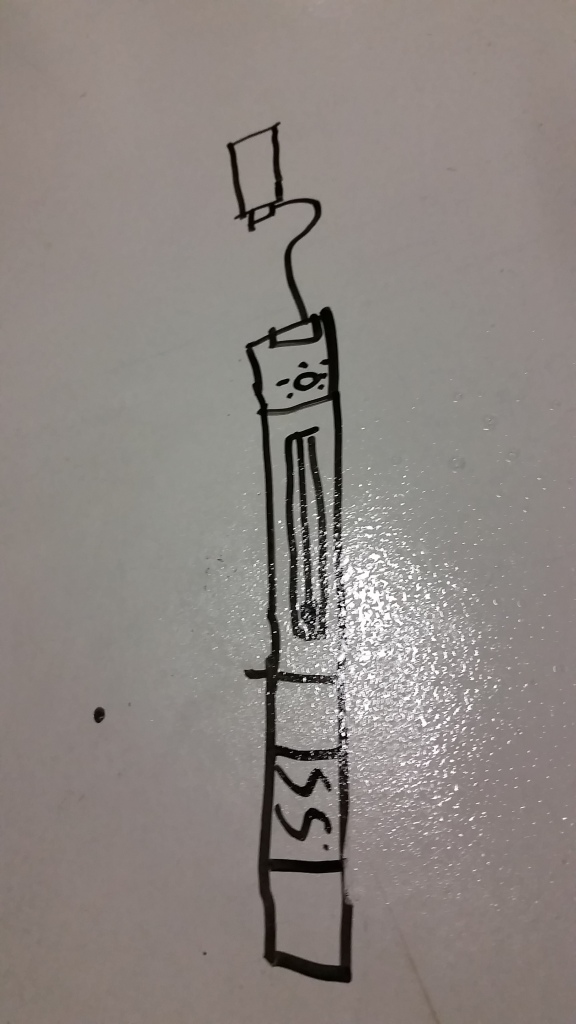 After the observations of the power and output circuits I (finally!) gave the pink input card holders the same directions as the green output card holders. If I have a criticism of this lesson it is that it takes a while for this last group to to get into the lesson, though they were watching intently. Once the pink card holders grabbed their inputs from the drawer they joined the teams and created new circuits, again writing down their observations on the table:
After the observations of the power and output circuits I (finally!) gave the pink input card holders the same directions as the green output card holders. If I have a criticism of this lesson it is that it takes a while for this last group to to get into the lesson, though they were watching intently. Once the pink card holders grabbed their inputs from the drawer they joined the teams and created new circuits, again writing down their observations on the table:
